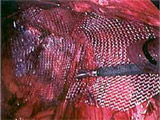Inguinal hernia surgery
The goal of the operation is to return the content of the hernial sack back into the abdominal cavity and to reinforce the weak location. It is strengthened by suturing the edges of the opening together in several layers and using different methods. For large openings (hernia gate) or recurrent hernias, a synthetic mesh is worked into the defective area. The operation may either be done in the classical manner, i.e., by cutting through the skin over the palpable hernia, or using laparoscopy (only for inguinal and femoral hernias). Laparoscopy is carried out only under general anesthesia. First, a special needle fills the abdominal cavity with carbon dioxide. Then, a few short cuts (1-2 cm) are made in the abdominal wall to introduce so-called trocars (usually metal or plastic tubes with a return valve to prevent the gas from leaking out of the inflated abdomen). These are then used to insert a special laparoscopy instrument and optical tube resulting in a picture on the monitor. The advantages of laparoscopy are the small incisions it requires in the abdominal wall and the lower level of postoperation pain, as well as better postoperation comfort for the patient. Cosmetic benefits are present, along with a reduced risk of recidivism, a shorter stay in the hospital and a shorter overall time off work. Recovery time after laparoscopy is 3-4 weeks, for classical surgery, 6-8 weeks.
Duration of surgery: 20 minutes
Length of hospital stay: 1–3 days


